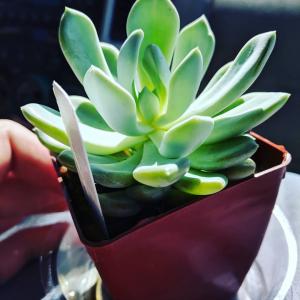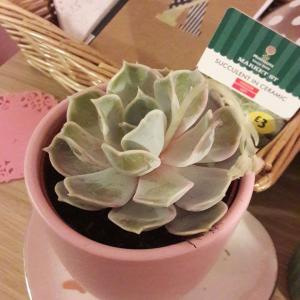成长记
katie.loves.plants
2018年05月11日

I now added "Succulent (unknown)" in my "garden"


1
0
Catarina ZS:it is a Crassula sarmentosa :-)
求助
Lucky Coyote
2018年05月10日

ID, please?
I got this succulent last year off of a hiking trail in Cottage Grove, Oregon
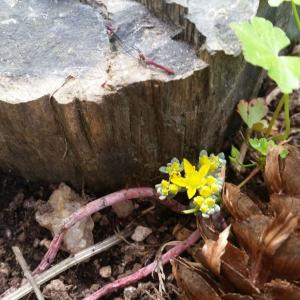
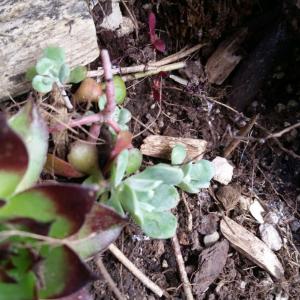
I got this succulent last year off of a hiking trail in Cottage Grove, Oregon


1
0
文章
Miss Chen
2018年05月10日

Description: This wildflower is a spring annual about 4-16" tall; it branches occasionally and is more or less erect. The stems are rather thick and succulent, pale green to pale purple, and glaucous; they have widely scattered to dense tufts of long white hairs. The lower leaves are opposite, while the upper leaves are alternate; they are widely spreading. Each leaf is up to 4" long and 1" across; it is simple pinnate or pinnate-pinnatifid in structure and oblong-ovate in outline. There are 7-13 narrow leaflets (or narrow lobes) on each leaf; they can be opposite or alternate. Each leaflet has 3-5 large teeth or cleft lobes. The upper surface of each leaf is medium to dark green and hairy. At the base of each leaf, there is a stout petiole that is flattened on top and somewhat hairy.
Individual flowers up to ¼" across are produced from the axils of the upper leaves; their pedicels are short, slender, and hairy. Each flower has a white or pale blue corolla with 5 petal-like lobes and a hairy green calyx with 5 large teeth. There may be fine purple lines within the interior of the corolla and tiny specks of purple on the petal-like lobes. The blooming period occurs from late spring to early summer and lasts about 1½ months. The flowers open up during the day; only a few flowers are in bloom at the same time. The corollas soon fall off, while the teeth of the calyxes become enlarged, spreading outward from their seed capsules. Each seed capsule is globoid, slightly bifid, and hairy; it contains 4 seeds. The seeds are brown, ovoid, and finely pitted. The root system consists of a taproot.
Cultivation: The preference is partial sun to light shade, moist to mesic conditions, and a fertile loamy soil with abundant organic matter. Most vegetative growth occurs during the spring; the foliage turns yellow and withers away during the summer.
Range & Habitat: The native Aunt Lucy is occasional to locally common in most areas of Illinois, except the SE section of the state, where it is uncommon or absent (see Distribution Map). Habitats include deciduous woodlands, gardens and nurseries, partially shaded areas along buildings, and waste places. This wildflower prefers locations where the ground vegetation is scant as a result of overhead shade or a recent disturbance.

Faunal Associations: The nectar of the flowers attracts various kinds of bees, including mason bees (Osmia spp.), little carpenter bees (Ceratina spp.), Halictid bees, and Andrenid bees. Bee flies (Bombyliidae) are also attracted to the nectar of the flowers, while Syrphid flies feed mostly on the pollen. According to Ada Georgia in A Manual of Weeds (1913), the bruised foliage of Aunt Lucy has a rank disagreeable odor, therefore it is avoided by livestock and probably other mammalian herbivores.
Photographic Location: The webmaster's wildflower garden in Urbana, Illinois, where this wildflower developed spontaneously.
Comments: Aunt Lucy is an oddball member of the Waterleaf family. It is not very showy and often omitted from many wildflower guides. Aunt Lucy occurs in two quite different habitats: deciduous woodlands and disturbed areas where the ground is bare or lightly mulched. In the former habitat, it is one of our native spring wildflowers, while in the latter habitat it is a minor weed of nurseries and bare open ground in cities. The leaves of Aunt Lucy are fairly distinctive and help to distinguish it from many other kinds of plants. It resembles to some extent Floerkia proserpinacoides (False Mermaid), except the latter species has greenish flowers with only 3 petals and 3 sepals, and its leaflets (or lobes) are more narrow and smooth.
Individual flowers up to ¼" across are produced from the axils of the upper leaves; their pedicels are short, slender, and hairy. Each flower has a white or pale blue corolla with 5 petal-like lobes and a hairy green calyx with 5 large teeth. There may be fine purple lines within the interior of the corolla and tiny specks of purple on the petal-like lobes. The blooming period occurs from late spring to early summer and lasts about 1½ months. The flowers open up during the day; only a few flowers are in bloom at the same time. The corollas soon fall off, while the teeth of the calyxes become enlarged, spreading outward from their seed capsules. Each seed capsule is globoid, slightly bifid, and hairy; it contains 4 seeds. The seeds are brown, ovoid, and finely pitted. The root system consists of a taproot.
Cultivation: The preference is partial sun to light shade, moist to mesic conditions, and a fertile loamy soil with abundant organic matter. Most vegetative growth occurs during the spring; the foliage turns yellow and withers away during the summer.
Range & Habitat: The native Aunt Lucy is occasional to locally common in most areas of Illinois, except the SE section of the state, where it is uncommon or absent (see Distribution Map). Habitats include deciduous woodlands, gardens and nurseries, partially shaded areas along buildings, and waste places. This wildflower prefers locations where the ground vegetation is scant as a result of overhead shade or a recent disturbance.

Faunal Associations: The nectar of the flowers attracts various kinds of bees, including mason bees (Osmia spp.), little carpenter bees (Ceratina spp.), Halictid bees, and Andrenid bees. Bee flies (Bombyliidae) are also attracted to the nectar of the flowers, while Syrphid flies feed mostly on the pollen. According to Ada Georgia in A Manual of Weeds (1913), the bruised foliage of Aunt Lucy has a rank disagreeable odor, therefore it is avoided by livestock and probably other mammalian herbivores.
Photographic Location: The webmaster's wildflower garden in Urbana, Illinois, where this wildflower developed spontaneously.
Comments: Aunt Lucy is an oddball member of the Waterleaf family. It is not very showy and often omitted from many wildflower guides. Aunt Lucy occurs in two quite different habitats: deciduous woodlands and disturbed areas where the ground is bare or lightly mulched. In the former habitat, it is one of our native spring wildflowers, while in the latter habitat it is a minor weed of nurseries and bare open ground in cities. The leaves of Aunt Lucy are fairly distinctive and help to distinguish it from many other kinds of plants. It resembles to some extent Floerkia proserpinacoides (False Mermaid), except the latter species has greenish flowers with only 3 petals and 3 sepals, and its leaflets (or lobes) are more narrow and smooth.
0
0
成长记
pzsoofi
2018年05月08日

Somewhat elongated in full sun... how much light does this plant need????
#Succulent
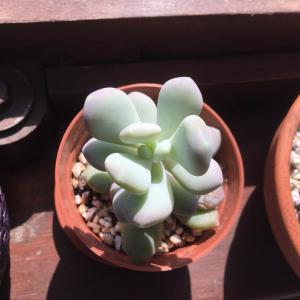

#Succulent


2
0
pzsoofi:@meriunkat thank for the tip! it might actually get more than that and pretty harsh too. Maybe summertime will help.
meriunkat:needs shade the rest of tge day
meriunkat:but not too harsh sunlight
meriunkat:about 6 hours every day
成长记
pzsoofi
2018年05月08日

Big momma and child, who is now also a momma! Three generations of purples and pinks 🌸🌸🌸
#Succulent #Echeveria
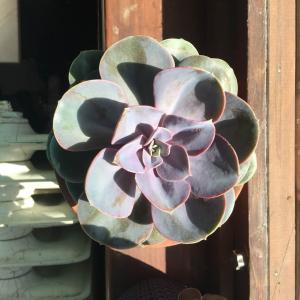
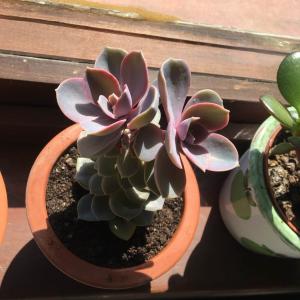
#Succulent #Echeveria


3
0
成长记
pzsoofi
2018年05月08日

Insane leaves on the palm trees!! and baby branches all over the big one, this is so exciting!
#Succulent
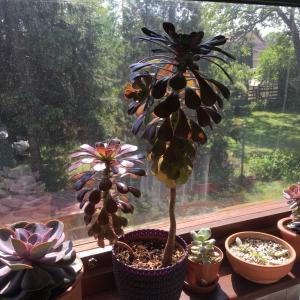
#Succulent

3
0
MrsMissy3477
2018年05月07日

My succulent collection 😄 I rescued 8 out of the 9 from a neglectful hardware store. They'll just need a bit of time, TLC, and propagating and they'll be at their best in no time!!
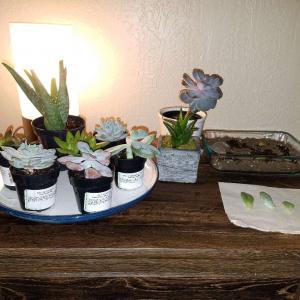

1
0
文章
Miss Chen
2018年05月06日

Description: This perennial wildflower is about 3-6" tall, consisting of a flowering stem with a pair of opposite cauline leaves and some basal leaves. The stem is light green or slightly reddish green, glabrous, and rather succulent. The basal leaves and the pair of cauline leaves are linear or linear-lanceolate, slightly recurved, glabrous, smooth along the margins, and slightly fleshy. There is a single central vein along the length of each leaf. The leaves are about 2-5" long; their width varies somewhat depending on the local ecotype, but it is usually about ¼" across. The stem terminates in a floppy raceme of flowers. Each flower is about 8 mm. (1/3") across when it is fully open, consisting of 5 petals, 2 green sepals, 5 stamens with pink anthers, and a pistil with a tripartite style. The petals are white with fine pink stripes; these stripes vary from pale pink to bright pink. The flowers open up on warm sunny days, and close during cloudy weather or at night. They are more or less erect while open, but nod downward while closed. The blooming period occurs from mid- to late spring and lasts about 1-2 months. There is a pleasant floral scent. Each fertile flower produces an ovoid capsule containing several seeds; this capsule is enclosed by the 2 persistant sepals. The root system consists of a small corm and secondary roots. This wildflower spreads by reseeding itself; sometimes it forms rather loose colonies of plants.
Cultivation: The preference is dappled sunlight during the spring, moist to slightly dry conditions, and a rich loamy soil with abundant organic matter. This wildflower will adapt to semi-shaded areas of lawns if mowing is delayed during the spring. Both the flowers and foliage fade away by mid-summer. The easy way to start plants is by obtaining their corms, although these are expensive to buy from nurseries.
Range & Habitat: The native Spring Beauty is a common wildflower that occurs in every county of Illinois (see Distribution Map). Habitats include moist to dry deciduous woodlands, savannas, thinly wooded bluffs, city parks, old cemeteries, and lawns (particularly near trees). Less often, this species is found in mesic prairies, but it is primarily a woodland plant. Spring Beauty can survive more environmental degradation than most spring-blooming woodland species, including occasional grazing by cattle and partial clearing of trees. This is one reason why it is still common.

Faunal Association: Aside from insect pollination, little is known about floral-faunal relationships. Various kinds of bees visit the flowers, include honey bees, bumblebees, little carpenter bees (Ceratina spp.), mason bees (Osmia spp.), cuckoo bees (Nomada spp.), Halictid bees (Agapostemon spp., Augochlorella spp., Halictus spp., Lasioglossum spp.), and Andrenid bees (Andrena spp.). An Andrenid bee, Andrena erigeniae, is a specialist pollinator of Spring Beauty. Many flies also visit the flowers, including Syrphid flies, the Giant Bee fly (Bombylius major), flesh flies (Sarcophagidae), and Calliphorid flies. Less often, various butterflies and skippers visit the flowers. These insects usually seek nectar, although some of the bees also collect pollen. The corms of Spring Beauty are dug up and eaten by some small rodents, including the White-Footed Mouse and Eastern Chipmunk (Martin et al., 1951/1961; Wrazen & Svendsen, 1978). The foliage is browsed sparingly by White-Tailed Deer (Augustine, 1997). While the corms of Spring Beauty can be eaten by humans as well, their small size makes this rather impractical.

Photographic Location: Busey Woods and an old cemetery in Urbana, Illinois.
Comments: This attractive wildflower is a sure sign that spring has arrived and that the local woodlands are full of wildflowers. When Spring Beauty and these other wildflowers are conspicuously absent from a woodlands, this indicates that it has been subjected to severe degradation from plows or bulldozers at some point in the past. In Illinois, Spring Beauty is a unique member of the Purslane family that is easy to distinguish from other wildflowers. Look for pink-stripes, whether pale or bright, on the petals of the flowers, and only 2 sepals underneath. In southeastern and other parts of the United States, there is a closely related wildflower, Claytonia carolina (Carolina Beauty). This latter species has a similar appearance to Spring Beauty, but it doesn't occur in Illinois. The leaves of Carolina Beauty are usually broader than those of Spring Beauty.
Cultivation: The preference is dappled sunlight during the spring, moist to slightly dry conditions, and a rich loamy soil with abundant organic matter. This wildflower will adapt to semi-shaded areas of lawns if mowing is delayed during the spring. Both the flowers and foliage fade away by mid-summer. The easy way to start plants is by obtaining their corms, although these are expensive to buy from nurseries.
Range & Habitat: The native Spring Beauty is a common wildflower that occurs in every county of Illinois (see Distribution Map). Habitats include moist to dry deciduous woodlands, savannas, thinly wooded bluffs, city parks, old cemeteries, and lawns (particularly near trees). Less often, this species is found in mesic prairies, but it is primarily a woodland plant. Spring Beauty can survive more environmental degradation than most spring-blooming woodland species, including occasional grazing by cattle and partial clearing of trees. This is one reason why it is still common.

Faunal Association: Aside from insect pollination, little is known about floral-faunal relationships. Various kinds of bees visit the flowers, include honey bees, bumblebees, little carpenter bees (Ceratina spp.), mason bees (Osmia spp.), cuckoo bees (Nomada spp.), Halictid bees (Agapostemon spp., Augochlorella spp., Halictus spp., Lasioglossum spp.), and Andrenid bees (Andrena spp.). An Andrenid bee, Andrena erigeniae, is a specialist pollinator of Spring Beauty. Many flies also visit the flowers, including Syrphid flies, the Giant Bee fly (Bombylius major), flesh flies (Sarcophagidae), and Calliphorid flies. Less often, various butterflies and skippers visit the flowers. These insects usually seek nectar, although some of the bees also collect pollen. The corms of Spring Beauty are dug up and eaten by some small rodents, including the White-Footed Mouse and Eastern Chipmunk (Martin et al., 1951/1961; Wrazen & Svendsen, 1978). The foliage is browsed sparingly by White-Tailed Deer (Augustine, 1997). While the corms of Spring Beauty can be eaten by humans as well, their small size makes this rather impractical.

Photographic Location: Busey Woods and an old cemetery in Urbana, Illinois.
Comments: This attractive wildflower is a sure sign that spring has arrived and that the local woodlands are full of wildflowers. When Spring Beauty and these other wildflowers are conspicuously absent from a woodlands, this indicates that it has been subjected to severe degradation from plows or bulldozers at some point in the past. In Illinois, Spring Beauty is a unique member of the Purslane family that is easy to distinguish from other wildflowers. Look for pink-stripes, whether pale or bright, on the petals of the flowers, and only 2 sepals underneath. In southeastern and other parts of the United States, there is a closely related wildflower, Claytonia carolina (Carolina Beauty). This latter species has a similar appearance to Spring Beauty, but it doesn't occur in Illinois. The leaves of Carolina Beauty are usually broader than those of Spring Beauty.
1
0
求助
Samantha
2018年05月02日

What kind of succulent is this? Has velvet like leaf and stem
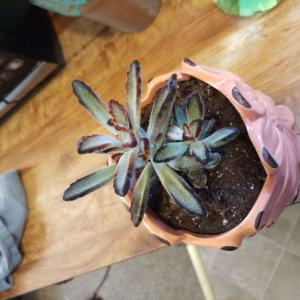

0
0
meriunkat:@Samantha you're welcome :)
Fion:巧克力兔耳(Kalanchoe Adans)
Samantha:thank you!
meriunkat:also known as Kalanchoe Tomentosa Chocolate Soldier
meriunkat:Kalanchoe Chocolate Soldier 'Panda plant'
求助
Samantha
2018年05月02日

What kind of succulent is this? I was thinking maybe an aloe vera but I'm not sure.
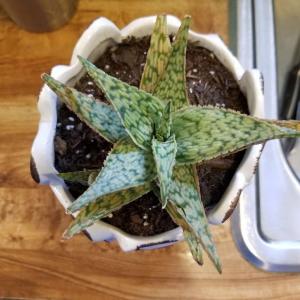
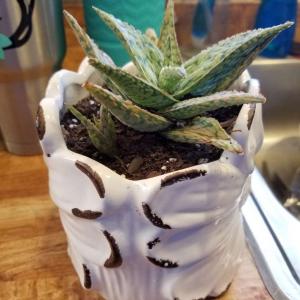


0
0
Fion:Yes, aloe vera, but I don't know your name either.
求助
JessAth
2018年04月30日

Why are some of the leaf drying out? i own this succulent 14 days and watered it once.


1
0
肉~:can you take a clearly picture at it's root?
我有18cm我先讲:能讲中文吗。
meriunkat:Stick your finger in the soil to find out
meriunkat:You should be watering after the soil is dry
meriunkat:Too much sunlight
显示更多



